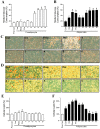2-Bromo-4'-methoxychalcone and 2-Iodo-4'-methoxychalcone Prevent Progression of Hyperglycemia and Obesity via 5'-Adenosine-Monophosphate-Activated Protein Kinase in Diet-Induced Obese Mice
- PMID: 30223438
- PMCID: PMC6163633
- DOI: 10.3390/ijms19092763
2-Bromo-4'-methoxychalcone and 2-Iodo-4'-methoxychalcone Prevent Progression of Hyperglycemia and Obesity via 5'-Adenosine-Monophosphate-Activated Protein Kinase in Diet-Induced Obese Mice
Abstract
Obesity and diabetes are global health-threatening issues. Interestingly, the mechanism of these pathologies is quite different among individuals. The discovery and development of new categories of medicines from diverse sources are urgently needed for preventing and treating diabetes and other metabolic disorders. Previously, we reported that chalcones are important for preventing biological disorders, such as diabetes. In this study, we demonstrate that the synthetic halogen-containing chalcone derivatives 2-bromo-4'-methoxychalcone (compound 5) and 2-iodo-4'-methoxychalcone (compound 6) can promote glucose consumption and inhibit cellular lipid accumulation via 5'-adenosine-monophosphate-activated protein kinase (AMPK) activation and acetyl-CoA carboxylase 1 (ACC) phosphorylation in 3T3-L1 adipocytes and C2C12 skeletal myotubes. In addition, the two compounds significantly prevented body weight gain and impaired glucose tolerance, hyperinsulinemia, and insulin resistance, which collectively help to delay the progression of hyperglycemia in high-fat-diet-induced obese C57BL/6 mice. These findings indicate that 2-bromo-4'-methoxychalcone and 2-iodo-4'-methoxychalcone could act as AMPK activators, and may serve as lead compounds for a new class of medicines that target obesity and diabetes.
Keywords: adipocyte; chalcone; flavonoid; halogen; skeletal muscle.
Conflict of interest statement
The authors declare no conflict of interest.
Figures








Similar articles
-
4-Hydroxyderricin and xanthoangelol from Ashitaba (Angelica keiskei) suppress differentiation of preadiopocytes to adipocytes via AMPK and MAPK pathways.Mol Nutr Food Res. 2013 Oct;57(10):1729-40. doi: 10.1002/mnfr.201300020. Epub 2013 May 16. Mol Nutr Food Res. 2013. PMID: 23681764
-
Fargesin improves lipid and glucose metabolism in 3T3-L1 adipocytes and high-fat diet-induced obese mice.Biofactors. 2012 Jul-Aug;38(4):300-8. doi: 10.1002/biof.1022. Epub 2012 Jun 2. Biofactors. 2012. PMID: 22674784
-
The Root Extract of Pueraria lobata and Its Main Compound, Puerarin, Prevent Obesity by Increasing the Energy Metabolism in Skeletal Muscle.Nutrients. 2017 Jan 4;9(1):33. doi: 10.3390/nu9010033. Nutrients. 2017. PMID: 28054981 Free PMC article.
-
Gly-Ala-Gly-Val-Gly-Tyr, a novel synthetic peptide, improves glucose transport and exerts beneficial lipid metabolic effects in 3T3-L1 adipoctyes.Eur J Pharmacol. 2011 Jan 10;650(1):479-85. doi: 10.1016/j.ejphar.2010.10.006. Epub 2010 Oct 14. Eur J Pharmacol. 2011. PMID: 20951125
-
Natural Chalcones for the Management of Obesity Disease.Int J Mol Sci. 2023 Nov 3;24(21):15929. doi: 10.3390/ijms242115929. Int J Mol Sci. 2023. PMID: 37958912 Free PMC article. Review.
Cited by
-
N-Octyl Caffeamide, a Caffeic Acid Amide Derivative, Prevents Progression of Diabetes and Hepatic Steatosis in High-Fat Diet Induced Obese Mice.Int J Mol Sci. 2022 Aug 11;23(16):8948. doi: 10.3390/ijms23168948. Int J Mol Sci. 2022. PMID: 36012215 Free PMC article.
-
The Effects of Engeletin on Insulin Resistance Induced in Human HepG2 Liver Cells.Curr Issues Mol Biol. 2025 Jul 10;47(7):535. doi: 10.3390/cimb47070535. Curr Issues Mol Biol. 2025. PMID: 40729004 Free PMC article.
-
Metabolic Impact of Flavonoids Consumption in Obesity: From Central to Peripheral.Nutrients. 2020 Aug 10;12(8):2393. doi: 10.3390/nu12082393. Nutrients. 2020. PMID: 32785059 Free PMC article. Review.
-
2-Iodo-4'-Methoxychalcone Attenuates Methylglyoxal-Induced Neurotoxicity by Activation of GLP-1 Receptor and Enhancement of Neurotrophic Signal, Antioxidant Defense and Glyoxalase Pathway.Molecules. 2019 Jun 16;24(12):2249. doi: 10.3390/molecules24122249. Molecules. 2019. PMID: 31208152 Free PMC article.
-
Mechanistic insights into dimethyl cardamonin-mediated pharmacological effects: A double control of the AMPK-HMGB1 signaling axis.Life Sci. 2020 Dec 15;263:118601. doi: 10.1016/j.lfs.2020.118601. Epub 2020 Oct 18. Life Sci. 2020. PMID: 33086122 Free PMC article. Review.
References
MeSH terms
Substances
Grants and funding
LinkOut - more resources
Full Text Sources
Other Literature Sources
Medical

